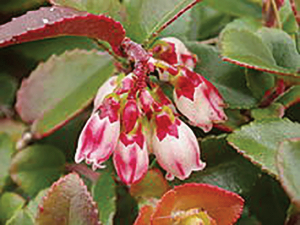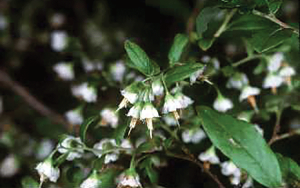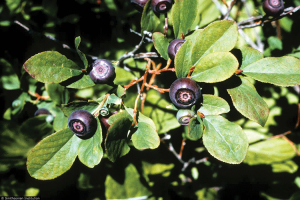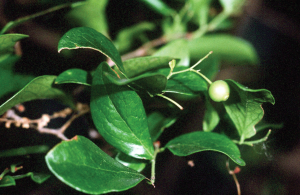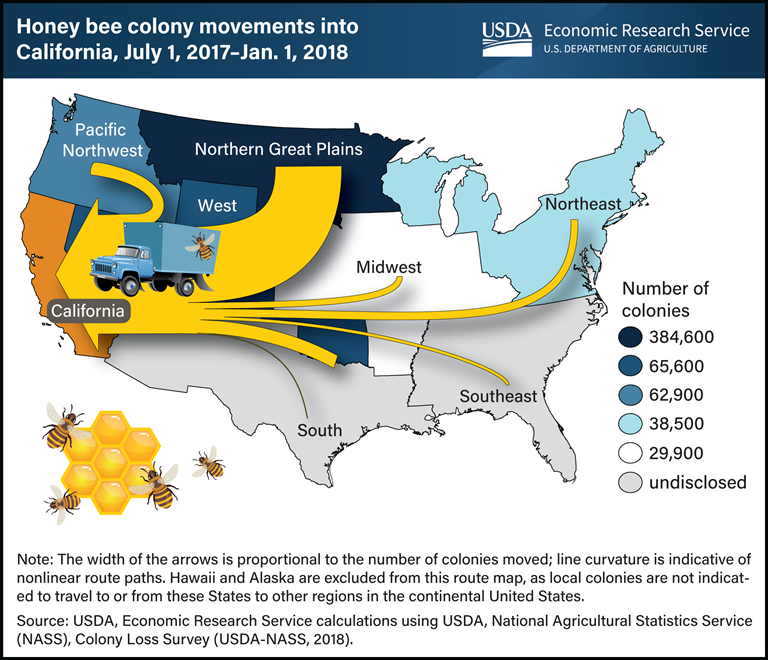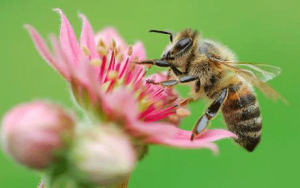 : Connie Krochmal
: Connie Krochmal
Two groups of bee plants are known as huckleberries – Vaccinium spp. and Gaylussacia spp. The former, which are most common in the West and are closely related to blueberries and cranberries, will be profiled this month. The others will appear in a future article.
Members of the heath family, these native species are found In North America in both the East and West. Hardiness can vary slightly by species. Some have a chill requirement. With the exception of the tree huckleberry, the plants are typically unsuitable for extremely warm areas.
These nectar plants help to build up colonies in the Spring. Certain species are known to be important honey plants – particularly in the West. When there is a honey surplus, this good quality, pale amber honey has a good flavor and body.
Habitats
Although the habitats differ slightly from one species to another, these species generally have several sites in common, such as woods, forests, clearings, woodland borders, and thickets. Some are adapted to dry, sandy soils. Most are suited to full sun and partial shade.
General Description
These native plants can sometimes be difficult to identify because they readily hybridize. Generally, huckleberries are shrubs although one species can be a small tree. Height and growth habit differs according to the species.
The leaves are mostly deciduous but are sometimes semi-evergreen. One species is evergreen. The shape, color, and size of the foliage can differ from one species to another. This can provide Fall color, usually orange or red.
Huckleberry blooms open during the Spring singly or in pairs, often on short clusters or racemes. Resembling urns or bells, the flowers generally emerge on current year’s growth, but are occasionally on old wood. These are often white or pink. The bloom time can differ slightly by species.
Fruit color, size, and shape can vary according to the species. Generally larger than blueberries, these contain hard, stony seeds that are larger than those of blueberries. The ripe fruits, generally harvested from wild plants, are used like blueberries. They were staple foods for some Native American tribes.
Growing Huckleberries
At least three species of huckleberries are cultivated. The plants are readily available from nurseries. Some species are grown as hedges and ground covers and in containers. Generally, huckleberries are more fruitful if they receive some sun.
The preferred soil and water needs differ slightly according to the species. However, most huckleberries prefer a moist, acid, well drained soil. At least one species tolerates an alkaline pH.
Some species are drought tolerant. The plants can generally be propagated by seeds, suckers, and layering. The smaller types should be spaced three to four feet apart.
Recommended Species for Bees
The following huckleberries are known to be good bee plants.
Blue huckleberry (Vaccinium deliciosum)
Sometimes called mountain huckleberry or blueleaf huckleberry, this shrub occurs in Washington, Oregon, Idaho, and California in alpine meadows and subalpine coniferous forests. It is suited to zones four through eight.
A little over a foot in height, the low growing, dense plant features smooth tufted stems. The thick toothed leaves are oblong to oval with whitish undersides.
Depending on the location, this can bloom from March to May. The globular pink blossoms open singly. During favorable weather, blue huckleberry brings much nectar. The plant bears edible, sweet tasting, aromatic, flavorful black fruits with a whitish bloom.
Deerberry (Vaccinium caesium)
Also known as squaw-huckleberry, this is native to the entire East from Maine, New York, Ohio, Indiana, and Illinois throughout the South and Gulf regions westward to Kansas, Missouri, and Texas. Deerberry is found in oak scrub, pine-scrub, floodplains, dry open woods, and mountains.
Suited to zones five through nine, this deciduous shrub reaches three feet in height. The growth can be hairy. The foliage, two inches in length, can be blue, whitish, or green underneath.
The white blooms with showy stamens open in small bracted clusters. The leaf-like bracts can have the same shape as the foliage. The blackish-blue fruits are covered with a whitish bloom.
Evergreen huckleberry
(Vaccinium ovatum)
Sometimes called California huckleberry, this occurs from Washington and Oregon to California. Florists use stems from the wild plants for floral arrangements. Due to overharvest, the species is threatened.
Evergreen huckleberry occurs as an understory shrub in mixed and low elevation forests. Suited to very poor, sandy soils, the plant is hardy to -10°F. Often grown as a hedge, this is tolerant of salt spray.
With a medium growth rate, this very leafy, compact, bushy, upright to spreading, dense plant features arching, stiff, hairy twigs. Evergreen huckleberry has a spreading growth habit when young. This free flowering plant is only two to three feet tall and wide when grown in sunny spots. In the shade, evergreen huckleberry can reach eight to 10 feet in height.
Usually toothed, the box-shaped, glossy, finely toothed, leathery, ovate to oblong leaves are deep green to bright green above and paler underneath. The young foliage is reddish-copper to bronze. The leaves are ¾ to three inches long.
From March to May, the small, bell-like, nodding blooms open from the leaf axils in dense, inch-long clusters. Only ¼ inch in length, the flowers can be pink or white. Sometimes, these have red tinges. The corolla features five short lobes.
The edible, spherical, blue-black or black fruits can have a whitish bloom. Smaller than blueberries, these have a tangy flavor.
Evergreen huckleberry can bring a small crop of honey, which is very good quality.
Scarlet huckleberry (Vaccinium parviflorum)
Sometimes called red huckleberry, this species is found from Alaska to California. Hardy to zone five, it is most common along the coast. The habitats include low to mid elevation mountains, bottomlands, dry open woods, and rotting logs. Requiring very acid conditions, scarlet huckleberry prefers a moist soil and a humid climate.
With a slow to moderate growth rate, this lovely, shade-tolerant, airy shrub is usually one to five feet tall but occasionally reaches 18 feet. It can be three to six feet across. The slender, light green, cascading or spreading stems are flattened.
The thin, greenish-blue to green, oblong leaves are deciduous or semi-evergreen, depending on the location. They’re relatively small – usually ½ inch or less in length, but these can be slightly larger.
The blooms typically open from April to May for around six weeks either singly or in pairs from the leaf axils. The rounded, one-fourth-inch-wide, urn shaped flowers are mostly white. Sometimes, these have pink or reddish tinges.
Remaining on the bush for weeks, the translucent, very showy, spherical berries ripen to a vivid red or pinkish-red. Over an inch in diameter, they’re quite flavorful.
Known to be a very good honey plant, scarlet huckleberry yields a mild tasting, very sweet, distinctive tasting, light amber honey. This is very thick and hard to extract.
Squaw-huckleberry
(Vaccinium stamineum)
Also called deerberry, this relatively fast growing shrub is found from Missouri and Minnesota into Indiana, Ohio, New York and Massachusetts southward to Georgia, Florida, and Louisiana.
Hardy to zone five, this very drought tolerant species inhabits various habitats, such as dry sandy pinelands and dry woods. Needing an acid soil, this plant spreads by underground stems. It tolerates a drier soil than some huckleberries. Squaw-huckleberry is a host of the blueberry maggot – a pest of blueberry plants.
The much branched, loose, airy plant features peeling bark and arching, twisted branches. Typically two to four feet in height and three feet across, squaw-huckleberry occasionally reaches 10 feet or so.
Older stems are grayish-brown. The young growth is hairy, especially the undersides of the leaves.
Variable in shape and size, the glossy, thick, alternate, deciduous foliage can be oval, ovate, oblong, or elliptic. The color ranges widely from green or greenish-blue to blue. The undersides of the leaves can be whitish, blue-gray, or gray-white. About ¾ to four inches long and half as wide, these can be very sparsely toothed.
The floriferous plants bear lovely, dainty, nodding, five-parted, small, bell-like blooms with flaring petals. They open in loose, leafy bracted sprays, 2½ inches long. These make their appearance in April and May from the leaf axils on old wood as the leaves unfurl. They’re considered to be the most beautiful of the huckleberry flowers.
The flowers can be white, cream, or light pink and sometimes have purple tinges. These feature long, stunning, orange-yellow stamens. The calyx has spreading lobes. The bracts are sometimes much smaller than the foliage.
Usually covered with a bloom, the dry, very seedy fruits, ½ inch wide, can be smooth or hairy. Often, they’re pear shaped to globose. Ripening from August to October, the berries are highly variable in color. They can be blue, black, reddish, purplish-black, green, yellow-green, yellow, pale purple, white, or blue-green. The flavor ranges from sweet to tart.
Thinleaf huckleberry
(Vaccinium membranaceum)
Sometimes called big huckleberry, this species is native over much of the West into Minnesota and Michigan. Hardy to zone six, this drought tolerant plant occurs in alpines and mountain meadows.
Thinleaf huckleberry grows from one to five feet in height. A dwarf, deciduous, upright, erect or loose ascending shrub with peeling bark, it features four-angled stems that can be hairy.
Up to 2¾ inches long, the small, bright green, thick, mostly smooth, finely toothed leaves are oblong to ovate. Both the Latin species name and common name refer to the thin foliage.
Emerging in Spring either with or after the foliage unfurls, the nodding blossoms, over ½ inch long, open singly from the leaf axils. These can be whitish-green or white with either green or pink tinges. The corolla is pinkish or greenish.
Thinleaf huckleberry bears the largest, best tasting huckleberries. The sub-globose fruits are black to purplish with a slight bloom. Ripening from August to early September, they taste sweet yet acid. The fruits are harvested commercially from wild plants – especially in the Rocky Mountains.
Tree huckleberry (Vaccinium arboreum)
Tree huckleberry occurs throughout the South from Virginia and Kentucky to Tennessee, Indiana, and Illinois westward to Missouri, Oklahoma, Kansas, and Texas. It is commonly found in dry, sandy, or rocky sites – particularly woods. An ideal understory plant, tree huckleberry thrives under taller trees.
With a slow to moderate growth rate, this species requires less water than blueberries. It adapts to a range of soil types, moisture levels, and pH levels – from acid to alkaline. The carefree plant requires minimal care.
Also called farkleberry, this is an excellent landscape plant. Either a coarse looking shrub or small tree, the erect, dense, upright, rounded, spreading plant has an open crown. It is suitable for zones six through 10.
Tolerant of drought and heat, this very floriferous plant is relatively long lived and slow growing. Typically six to 15 feet tall with a four to ten foot spread, the plant sometimes reaches 20 to 25 feet in height under ideal conditions. Best grown as a multi-stemmed tree, this has a trunk that can reach a foot in diameter.
This plant is noted for the twisted trunks, branches, and twigs, all of which can be hairy. The very colorful, striking, thin bark is a mix of rich browns along with purple, orange, and gray.
The alternate, shiny, thick, leathery leaves can be evergreen or semi-evergreen. Deep green above, these are lighter beneath. The shape ranges from oblong or elliptic to oval. From one to 2½ inches long, the foliage can provide red or pink color in the Fall.
This floriferous plant blooms when very young. The pendant, scented, white or pink, bell-shaped blossoms with white corollas open singly on long, showy, loose, leafy clusters. These emerge from the leaf axils as the leaves emerge from April to June on older wood. The bracts are smaller with a different shape than the foliage.
The firm, dry, mealy berries have a bland taste. Ripening in September and October, they cling to the plant for weeks.
This is an important honey plant in some areas though it doesn’t produce a surplus crop every year.
Connie Krochmal is a writer and beekeeper in Black Mountain, North Carolina.







